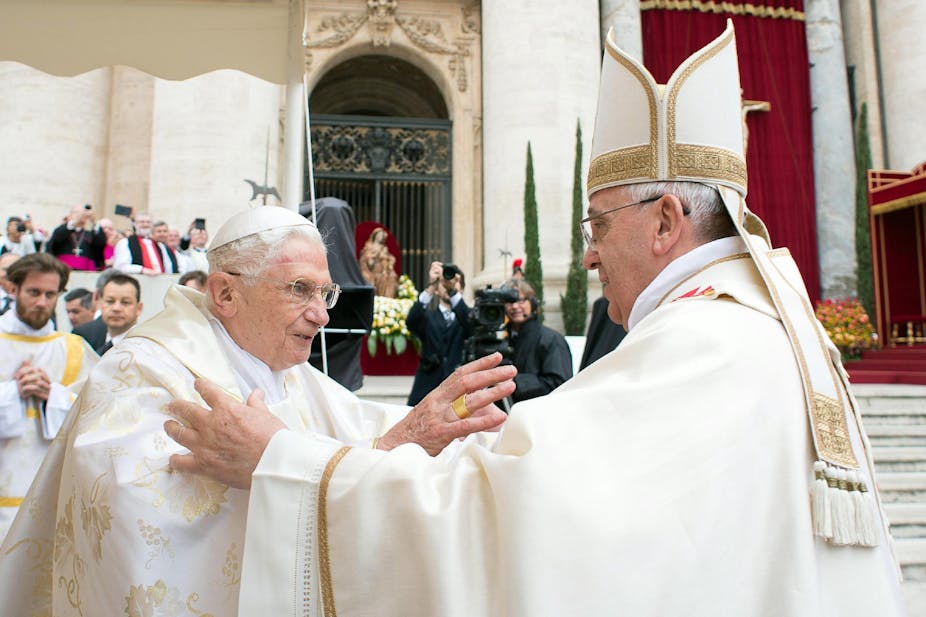The week after Easter, Pope Francis presided over the canonisation ceremony which declared his two most famous contemporary predecessors, John Paul II and John XXIII, were now “saints”. This is an important marker in his papacy, a transparently political act which seeks to balance the canonisation of the deeply conservative John Paul II with a simultaneous nod to John XXIII, who reigned from 1958 to 1963 and unleashed the progressive reforms of Vatican II.
Saints are the most distinctive part of the Catholic church’s symbolic world. From the courage of martyr saints to the eccentric ecstasies of its mystics, they people catholic theology, providing both illustration and inspiration. But they are not just resources for personal piety.
They are a powerful part of the church’s international political theatre. Canonisations are in some senses a pacifying, distracting ritual – but they are always also an important statement about the church’s key values.

The canonisation of John Paul II seemed inevitable since the chants at his funeral in 2005: “Sancto subito” – sainthood immediately. The process started when his successor Pope Benedict, forever the loyal lieutenant, waived the standard five-year waiting period.
The news of the lesser-known John XXIII’s elevation comes with its own exception: Francis waived the normal requirement of a second miracle in the Italian’s case.
This unusual move seems to indicate that the current pope is aware that he needed to balance his message by canonising two men regarded as representing different ends of the theological spectrum.
As an ecumenical gesture to different factions in the church the canonisations might be seen as a strategic and welcome step in a process of reconciliation badly needed in a divided church. But can the spirit of openness and questioning propagated by John XXIII, and seen by many to be renewed by Francis, be genuinely celebrated alongside the authoritarianism of John Paul II who policed any questioning in the church with the suppression of dissident views?
Even more significantly, John Paul didn’t merely lead his flock in a more conservative direction.
His pontificate is forever tainted by the priestly sex abuse crisis and it was only at the very end of his pontificate after a decade of public scandal, that John Paul spoke forthrightly about the issue. At the time of his beatification in 2011 – the stage in the Catholic “sainting” process that precedes canonisation – the Boston Globe quite rightly described him as “a flawed man who presided over a church that was guilty of one of the biggest institutional cover-ups of criminal activity in history.”
Canon lawyer Tom Doyle, one of the first figures to bring the depth of the scandal to light, and who wrote the earliest report to the Vatican on the crisis, put it this way:
Hundreds of thousands of lives were ruined because this pope looked the other way, and now they are falling over themselves to make him a saint … It is self-serving, and it is counterproductive, more evidence that the people who run the church don’t understand that these very actions are driving people from the church. It mystifies me. And when I think of the survivors of sexual abuse, it saddens and angers me.

Since his election, Pope Francis has deftly captured the world’s attention with surprising symbolic gestures.
At first blush the twin canonisation announcement seems like another theological parable wrapped in a good news story. But looked at more closely it’s the very type of use of institutional power that led to the systematisation of abuse within the church.
John Paul’s defenders immediately began to muster a defense) as soon as opposition to the Polish pontiff’s canonisation began to surface: it is the man not his papacy that is being canonised.
But trying to divorce personal sanctity from institutional leadership is the kind of thinking at the heart of the church’s response to clerical sex abuse. It was a response which valued institutional reputation and preservation of leadership over the lives of its members.
Back in medieval times the cults of the saints were controlled by their church biographers; the faithful believed what they were told. They longed for the most unrealistic measures of miraculous sanctity.
In a mediated world hagiography is quickly exposed. John Paul II was a charismatic leader but he was not a saint. Any thinking person who has been reading the news knows it. To pretend that he was perpetuates the mindset central to the church’s sex abuse crisis: it valorises and absolves the church’s leadership class while ignoring the rights and stories of the abused.
The decision to canonise John Paul II is not just symbolically and politically wrong-footed, theologically it ignores the suffering Christ embodied in the church’s victims. It clearly shows the church has yet to fully accept responsibility for the scandal in its midst.
Disappointingly it seems to indicate that Francis is more concerned with sanctifying the past than courageously defining a new future for his troubled church.

